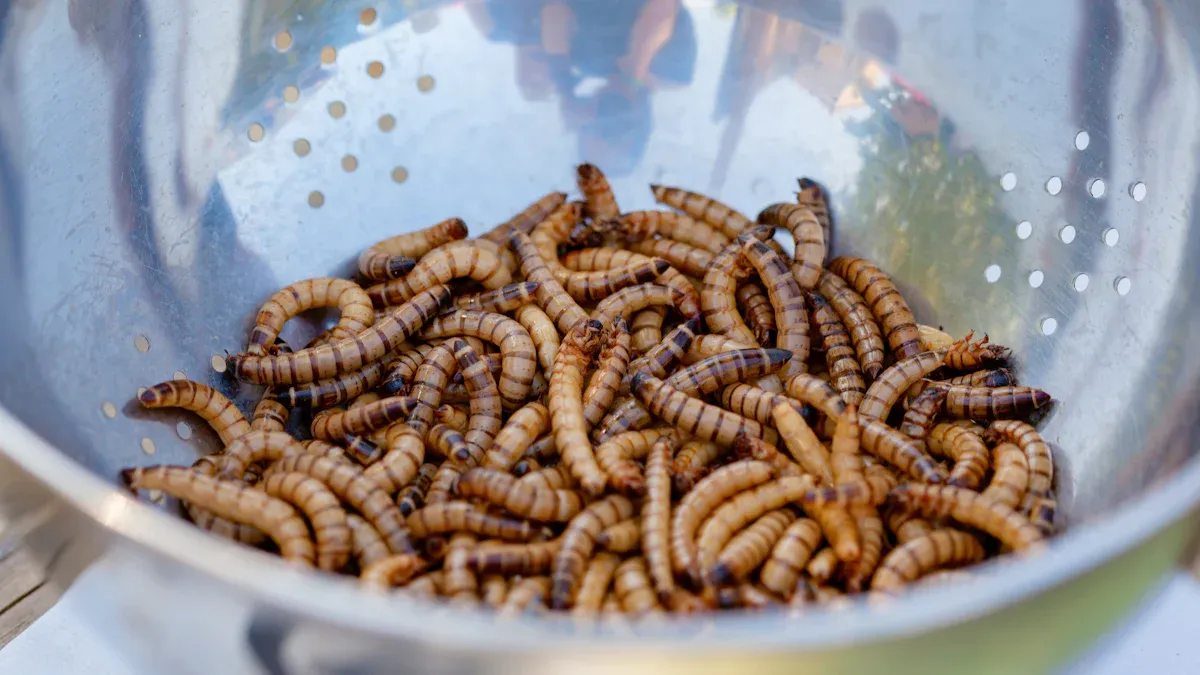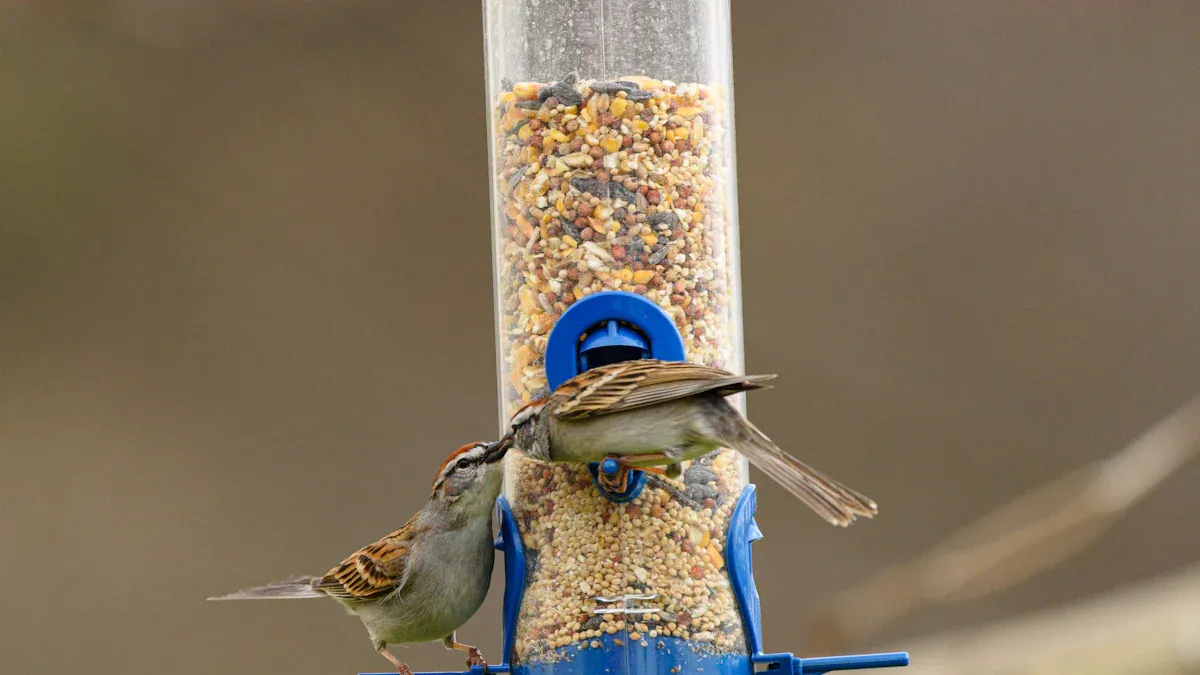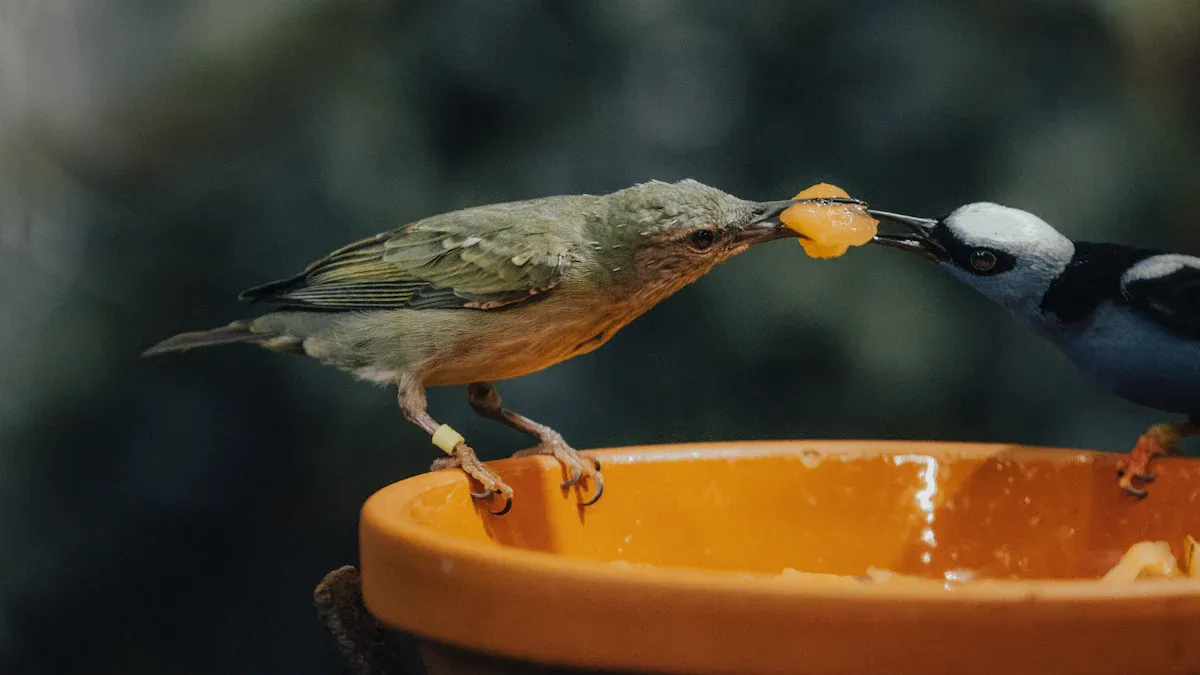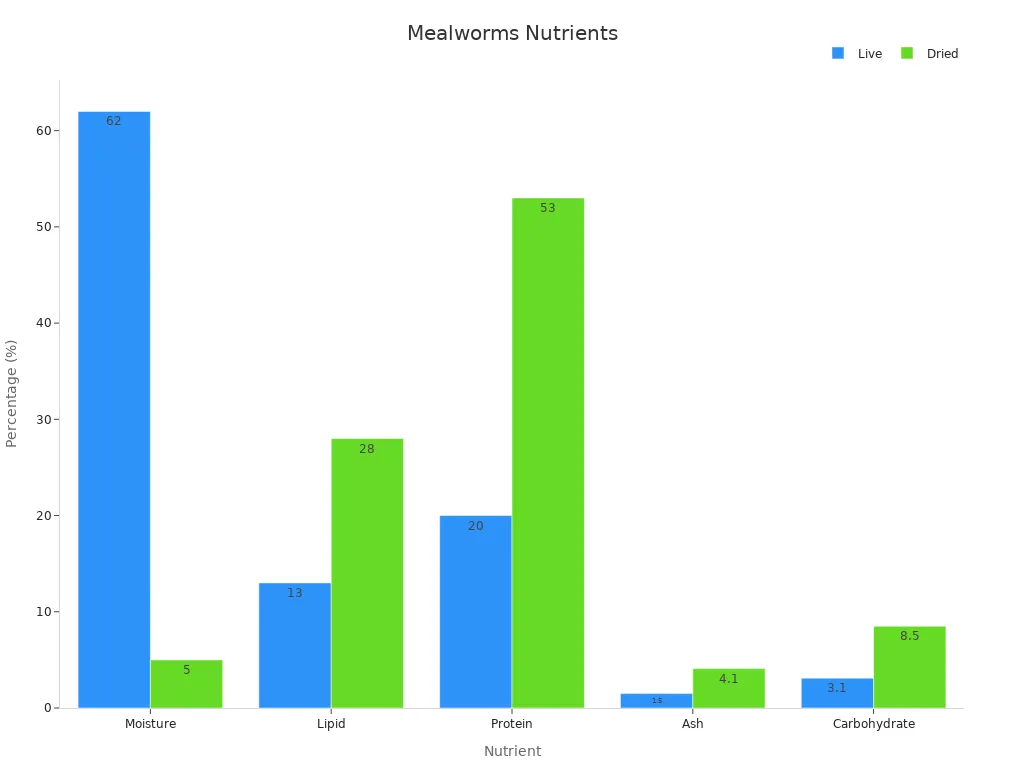
Mealworms bird food is a game-changer for bird lovers in 2025. Packed with nutrients, this natural option boosts bird health and vitality. Dried mealworms are convenient and rich in protein, making them perfect for supporting growth, energy, and overall well-being. Birds thrive when mealworms are part of their diet.
المداخل الرئيسية
- Mealworms are full of protein, which helps birds grow and stay active. Adding them to their food improves their health.
- Dried mealworms are easy to store and last longer. They give birds lots of nutrients for strong growth and energy.
- Change how you feed birds depending on the season. Mealworms give birds energy in winter and help them reproduce in spring.
Nutritional Benefits of Mealworms Bird Food

High-Quality Protein for Growth and Energy
Protein is the building block of life, and birds need plenty of it to grow strong and stay active. Mealworms bird food is an excellent source of بروتين عالي الجودة, making it a perfect addition to any bird’s diet. Whether it’s wild birds or poultry, the protein in mealworms supports muscle development, energy production, and overall vitality.
Studies show that dried mealworms contain up to 50% crude protein on a dry matter basis. This makes them comparable to traditional protein sources like soybean meal and fishmeal. Here’s a quick comparison of protein content:
| المصدر | Crude Protein Content (%) | Essential Amino Acids Comparison |
|---|---|---|
| Fresh Mealworm | >20% | High in essential amino acids |
| Dried Mealworm Meal | 50% (dry matter) | Comparable to soybean meal |
| Soybean Meal | N/A | Standard protein source |
| Fishmeal | N/A | Comparable or higher than MWM |
Birds that consume mealworms often show improved growth, better immune systems, and enhanced energy levels. For example:
- Broiler chickens fed mealworms experience better growth performance.
- Japanese quails and barbary partridges show improved carcass quality.
Adding mealworms bird food to your bird’s diet ensures they get the protein they need to thrive.
Essential Fats and Nutrients for Overall Health
Mealworms are not just about protein—they’re also packed with essential fats and nutrients that keep birds healthy. These fats, including oleic acid and linoleic acid, play a crucial role in maintaining energy levels, supporting cell function, and promoting shiny feathers.
Here’s a breakdown of the nutrient content in mealworms:
| نوع المغذيات | Amount (per 100g) |
|---|---|
| Fatty Acids | 6.16g |
| Linoleic Acid | Present |
The fats in mealworms bird food provide a concentrated energy source, which is especially important during colder months when birds need extra fuel to stay warm. Additionally, the vitamins and minerals in mealworms contribute to stronger bones, better digestion, and overall vitality. Birds that consume mealworms regularly often display vibrant plumage and increased activity levels.
Supporting Reproductive Performance and Molting
Reproduction and molting are demanding processes for birds, requiring extra nutrients to ensure success. Mealworms bird food provides the perfect nutritional boost during these critical periods. The high protein content aids in egg production, while the essential fats and amino acids support feather regrowth during molting.
Farmers and bird enthusiasts have noticed significant improvements in reproductive performance when mealworms are included in the diet. Birds lay more eggs, and the eggs are often larger and healthier. During molting, mealworms help birds replace their feathers quickly, ensuring they stay protected and warm.
By choosing mealworms bird food, you’re not just feeding your birds—you’re giving them the tools they need to thrive, reproduce, and look their best.
Birds That Thrive on Mealworms Bird Food
Wild Birds Commonly Attracted to Mealworms
Mealworms bird food is a magnet for wild birds. Species like blue tits, great tits, house sparrows, blackbirds, robins, starlings, and thrushes are drawn to this protein-packed treat. Observational data shows that 93% of birds prefer mealworms over other food sources like buffalo worms or sunflower seeds. This makes mealworms an excellent choice for bird enthusiasts looking to attract a diverse range of feathered visitors to their gardens.
Eastern bluebirds, in particular, have benefited from mealworm supplementation. Since the 1970s, their population has rebounded significantly due to improved foraging success and higher antibody responses to parasites. Projects like the Nest Parasite Community Science Project highlight how mealworms can enhance the health and survival of wild birds.
Pet Birds and Their Dietary Needs
Pet birds thrive on balanced diets, and mealworms bird food offers the perfect nutritional boost. Packed with 53% protein, 28% fat, and 6% fiber, dried mealworms provide essential nutrients for growth, energy, and feather health. Live mealworms, while lower in protein and fat, still offer valuable nutrition.
Studies show that mealworms improve bone mineralization and density in birds like chickens and geckos. Their calcium-to-phosphorus ratio of 1.5 supports strong skeletal development. Pet birds fed mealworms often display vibrant plumage, increased activity, and better overall health.
Seasonal Feeding Considerations
Birds’ nutritional needs change with the seasons. During colder months, mealworms bird food provides the extra energy birds need to stay warm. In spring, mealworms support reproductive health, helping birds lay healthier eggs. Summer feeding ensures birds stay active and vibrant, while fall supplementation aids molting and feather regrowth.
By adjusting feeding practices to match seasonal needs, bird lovers can ensure their feathered friends thrive year-round. Mealworms are a versatile option that caters to these changing requirements, making them a staple for bird care.
Practical Tips for Feeding Mealworms Bird Food

Choosing Between Live and Dried Mealworms
Bird enthusiasts often wonder whether live or dried mealworms are better for their feathered friends. Both options have unique benefits, and the choice depends on the birds’ needs and the feeder’s convenience.
Live mealworms are rich in moisture, making them an excellent hydration source for birds, especially during warmer months. They also mimic the natural diet of wild birds, encouraging foraging behavior. However, live mealworms require proper storage and care to keep them fresh and active.
Dried mealworms, on the other hand, are a more convenient option. They have a longer shelf life and are easier to store. With higher protein and fat content, dried mealworms provide concentrated nutrition, making them ideal for supporting growth, reproduction, and molting.
Here’s a quick comparison of their nutritional profiles:
| نوع الديدان | Moisture | Lipid (Fat) | Protein | Ash | Carbohydrate |
|---|---|---|---|---|---|
| Live | 62% | 13% | 20% | 1.5% | 3.1% |
| Dried | 5% | 28% | 53% | 4.1% | 8.5% |

For bird lovers seeking convenience and maximum nutrition, dried mealworms are often the preferred choice. They are particularly effective when used as a staple in mealworms bird food.
Best Practices for Feeder Types and Placement
The right feeder and placement can make all the difference in attracting birds and ensuring they get the most out of their mealworms.
-
Choose the Right Feeder:
Opt for feeders designed specifically for mealworms. Tray feeders work well for dried mealworms, while live mealworms are best served in smooth-sided dishes to prevent escape. -
Placement Matters:
Place feeders in areas that are safe from predators but easily accessible to birds. Hanging feeders near shrubs or trees provides a sense of security for wild birds. For pet birds, ensure the feeder is within their enclosure but away from water sources to prevent contamination. -
Keep Feeders Clean:
Regularly clean feeders to prevent the buildup of bacteria or mold. This is especially important when using live mealworms, as their moisture content can attract unwanted pests.
By following these tips, bird enthusiasts can create a safe and inviting feeding environment that encourages birds to return time and again.
Mixing Mealworms with Other Bird Foods
While mealworms are a powerhouse of nutrition, combining them with other bird foods can create a balanced diet that meets all of a bird’s dietary needs.
-
Why Mix Mealworms?
Mealworms can replace or partially replace traditional protein sources like fishmeal or soybean meal in poultry diets. Studies show that birds fed a mix of mealworms and other foods experience comparable or even superior growth and digestibility. -
What to Mix With Mealworms?
Wheat bran is an excellent base for mixing with mealworms. Adding yeast (S. cerevisiae) or bacterial diets (B. clausii) to the mix can further enhance the nutritional profile. This combination supports optimal growth and development in birds. -
How to Mix Mealworms?
Start by adding a small portion of mealworms to the bird’s regular food. Gradually increase the amount until it makes up about 10-20% of their diet. This ensures birds adapt to the new food without digestive issues.
By mixing mealworms with other foods, bird lovers can provide a diverse and nutrient-rich diet that supports their birds’ health and vitality.
Dried mealworms are transforming bird care in 2025. Their high protein and nutrient content make them a go-to choice for enhancing bird health and productivity.
- The mealworms feed market is growing rapidly due to their nutritional benefits.
- Poultry feed leads the way, boosting growth rates, egg production, and overall vitality.
- Mealworms provide essential vitamins and fatty acids, supporting birds year-round.
Incorporating mealworms into avian diets is a simple yet impactful step toward healthier, thriving birds.
Article author: Felix
FAQ
ما الذي يجعل الديدان المجففة أفضل من الديدان الحية؟?
Dried mealworms last longer and are easier to store. They also pack more protein and fat, making them a convenient and nutritious choice for birds. 🐦
Can mealworms replace other bird foods entirely?
Mealworms are nutrient-rich but work best as part of a balanced diet. Mixing them with seeds or grains ensures birds get all essential nutrients.
How often should birds be fed mealworms?
Feed mealworms 2-3 times weekly. Adjust frequency based on the bird’s size, species, and seasonal needs for optimal health and energy.


